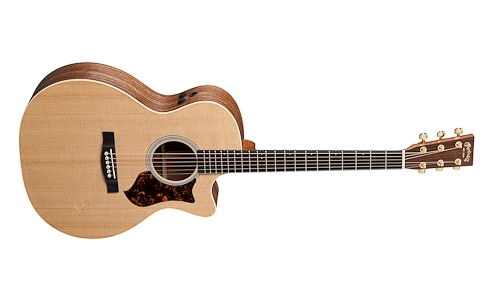Review: Martin GPCPA4 Siris

The following content is related to the September 2012 issue of Guitar World. For the full range of interviews, features, tabs and more, pick up the new issue on newsstands now, or in our online store.
Countless guitar makers have painstakingly copied every detail of Martin’s most popular steel-string acoustics over the years, but when it comes right down to it, only a Martin sounds like a Martin. Any guitarist who is serious about playing acoustic guitar should have at least one Martin in his arsenal, and with the wide selection of models offered by Martin today—from their timeless classics to their progressive new models—there is a Martin guitar to satisfy any player’s preferences.
The GPCPA4 Siris is one of two new models in Martin’s Performing Artist Series made from a tonewood called siris, a hard and durable dark-orange-hued wood from Northern India also known as East Indian walnut. Similar to rosewood, but denser, siris produces comparably deep bass, pronounced mids and crisp treble while it enhances sustain. This tone wood coupled with the GPCPA4 Siris’ Fishman F1 Analog preamp/pickup system showcases a devotion to innovation and enhancement that is keeping Martin one step ahead of its many imitators.
FEATURES
The GPCPA4 Siris features Martin’s Grand Performance cutaway body shape, which is similar to an OM model but with rounded upper-bout shoulders instead of the OM’s square shoulders. The guitar is constructed entirely of solid woods, including the Sitka spruce top, siris sides and the three-piece back, which is fabricated from two siris “wings” and an East Indian rosewood center wedge. Martin vaguely lists the neck material as “solid hardwood,” and the neck on my example looked like mahogany. The fretboard and “belly” bridge are made of Richlite, which is a natural fiber composite of recycled tree pulp and phenolic resin that possesses extraordinary hardness and strength.
The neck provides Martin’s traditional 25.4-inch scale length, 20 frets and a fretboard width of 1 3/4 inches at the nut. The guitar’s curvy appearance is enhanced by modest decorations. Fingerboard position markers consist of small dot inlays placed between the low E and A string (plus an extra dot at the 12th fret between the A and D string), and the back and top are surrounded by single-ply grained ivoroid binding. The neck, back and sides feature a smooth satin finish, while the top is sprayed with a mirror-like gloss finish.
Like the GPCPA4 Siris’ appearance, the factory-installed Fishman F1 Analog preamp/pickup system is simple and elegant. Two button-like controls and a similar-size LED are mounted in a triangular configuration on the upper bass bout just above the waist. A digital chromatic tuning function calibrated to A=440 is accessed by pressing down the volume control until the LED lights up. The tone control sweeps from no EQ (fully counter clockwise) to a “scooped-mid” tone with the knob in the full clockwise position. Pressing down the tone knob engages a variety of phase settings to suppress feedback and provide optimum bass response.
All the latest guitar news, interviews, lessons, reviews, deals and more, direct to your inbox!
PERFORMANCE
Unplugged, the GPCPA4 Siris produces lively, brilliant tone with ample sustain and resonance. The bass may not be as booming as a Martin dreadnought, but this is actually a good thing for guitarists who will amplify the instrument, as no low-end roll off is necessary. This also gives the guitar a more balanced overall tone, with midrange becoming slightly more prominent and treble exhibiting plenty of attractive shimmer. The GPCPA4 Siris sounds big and full when chords are strummed, and players can strike the strings quite forcefully before the top overdrives. Thanks to its siris back and sides and Hybrid “X” Scalloped bracing pattern, the guitar’s volume output is so impressive that many players in more intimate settings may prefer not to plug it in.
The Fishman F1 Analog preamp and under-saddle pickup preserve much of the guitar’s natural tonal beauty when amplified. The pickup produces warm sound with none of the harsh upper-midrange overtones often encountered with piezo pickups. The tone control mainly works like a midrange cut—fingerstyle players probably won’t want to go past the 12 o’clock position, while rhythm players working with other instruments will enjoy how the sound cuts through the mix with the tone control at 2 o’clock or higher. The tuner is very accurate and easy to use, showing the note being played and illuminating a green segment when properly tuned.
The Performing Artist neck profile is relatively shallow and rounded, with just the slightest hint of a “V” between the first and fifth frets. The guitar still has that beloved Martin action, with a little extra comfort and playing ease.
Chris is the co-author of Eruption - Conversations with Eddie Van Halen. He is a 40-year music industry veteran who started at Boardwalk Entertainment (Joan Jett, Night Ranger) and Roland US before becoming a guitar journalist in 1991. He has interviewed more than 600 artists, written more than 1,400 product reviews and contributed to Jeff Beck’s Beck 01: Hot Rods and Rock & Roll and Eric Clapton’s Six String Stories.

